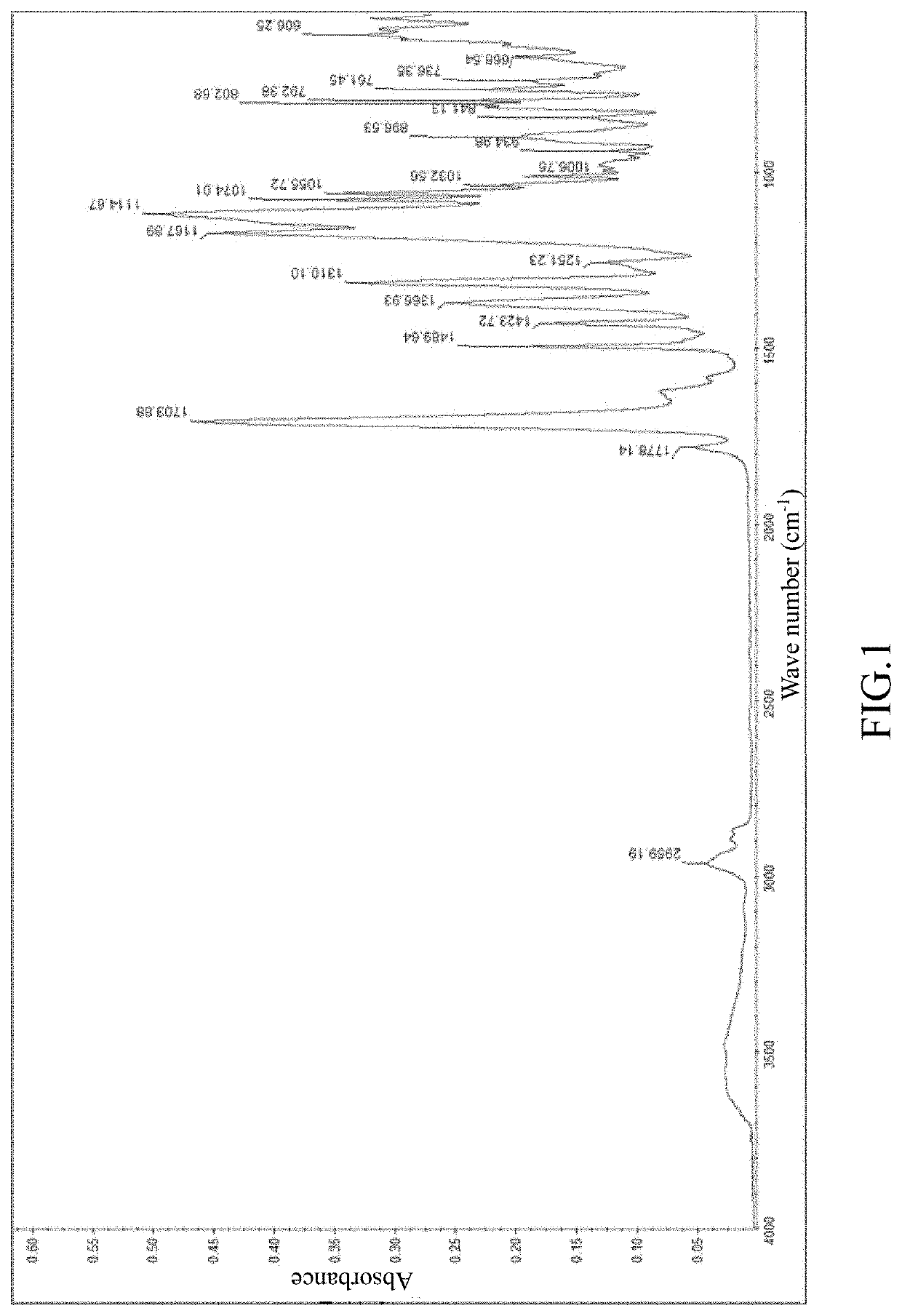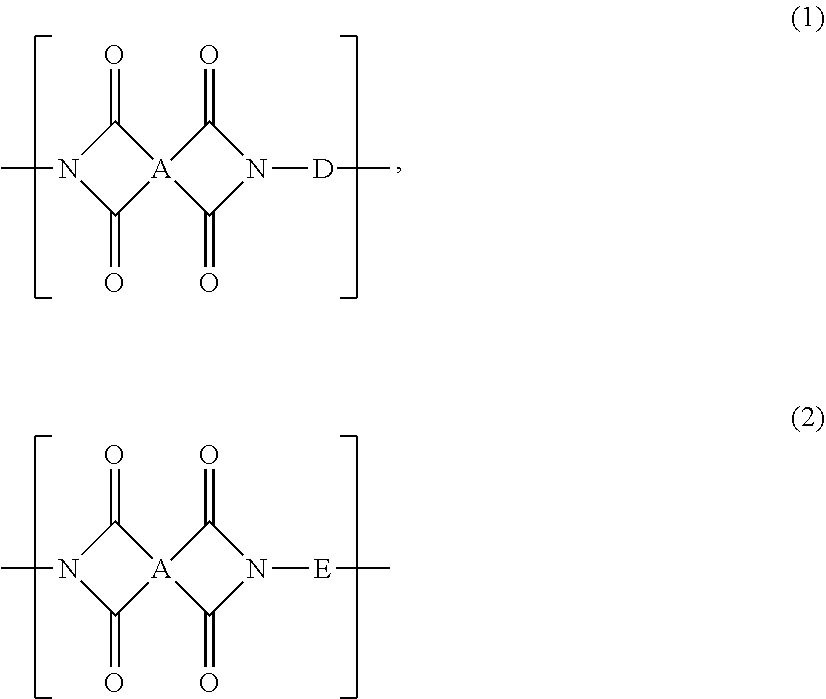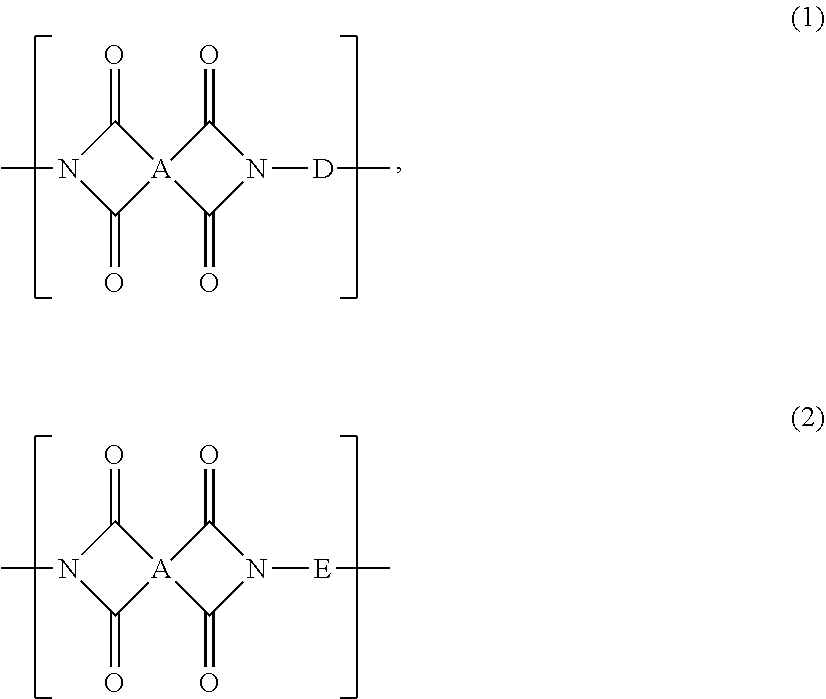Polyimide And Film Formed Therefrom
- Summary
- Abstract
- Description
- Claims
- Application Information
AI Technical Summary
Benefits of technology
Problems solved by technology
Method used
Image
Examples
example 1
[0053]4.5 mmol (mmole) of 2,2′-bis(trifluoromethyl)-[1,1′-biphenyl]-4,4′-diamine (TFMB) and 0.5 mmol of 3,5-diaminobenzamide were added into the reaction vessel and dissolved in N-methylpyrrolidone (NMP) with stirring in nitrogen atmosphere. The amount of solvent was equivalent to 20% by weight of the total solid weight content. After it was completely dissolved, 5 mmol of norbornane-2-spiro-α-cyclopentanone-α′spiro-2′-norbornane-5,5′,6,6′-tetracarboxylic dianhydride (CpODA) was added and stirred for 15 minutes. Afterwards, 3.2 mmol of isoquinoline were added and the reaction temperature was raised to 200° C. The reaction and polymerization were carried out for 24 hours to obtain the polyimide solution. The content of the amide group accounts for 10% of the number of moles of the polyimide. The content of the amide group in the polyimide is 0.156 mmol / g. As shown in FIG. 1, the polyimide in this polyimide solution has at least the following absorption peaks: 2959.19 cm−1(N—H), 1778....
example 2
[0054]4.5 mmol of 2,2′-bis(trifluoromethyl)-[1,1′-biphenyl]-4,4′-diamine (TFMB) and 0.5 mmol of 5,5′-methylene bis(2-aminobenzamide) were added into the reaction vessel and dissolved in N-methylpyrrolidone (NMP) with stirring in nitrogen atmosphere. The amount of solvent was equivalent to 20% by weight of the total solid weight content. After it was completely dissolved, 5 mmol of norbornane-2-spiro-α-cyclopentanone-α′spiro-2′-norbornane-5,5′,6,6′-tetracarboxylic dianhydride was added and stirred for 15 minutes. Afterwards, 3.2 mmol of isoquinoline were added and the reaction temperature was raised to 200° C. The reaction and polymerization were carried out for 24 hours to obtain the polyimide solution. The content of the amide group accounts for 20% of the number of moles of the polyimide. The content of the amide group in the polyimide is 0.080 mmol / g.
example 3
[0055]4.5 mmol of 2,2′-bis(trifluoromethyl)-[1,1′-biphenyl]-4,4′-diamine (TFMB) and 0.5 mmol of 3,5-diaminobenzamide were added into the reaction vessel and dissolved in N-methylpyrrolidone (NMP) with stirring in nitrogen atmosphere. The amount of solvent was equivalent to 20% by weight of the total solid weight content. After it was completely dissolved, 4 mmol of norbornane-2-spiro-α-cyclopentanone-α′spiro-2′-norbornane-5,5′,6,6′-tetracarboxylic dianhydride and 1 mmol of 3,3′,4,4′-biphenyltetracarboxylic dianhydride (s-BPDA) were added and stirred for 15 minutes. Afterwards, 3.2 mmol of isoquinoline were added and the reaction temperature was raised to 200° C. The reaction and polymerization were carried out for 24 hours to obtain the polyimide solution. The content of the amide group accounts for 10% of the number of moles of the polyimide. The content of the amide group in the polyimide is 0.152 mmol / g.
PUM
| Property | Measurement | Unit |
|---|---|---|
| Temperature | aaaaa | aaaaa |
| Temperature | aaaaa | aaaaa |
| Fraction | aaaaa | aaaaa |
Abstract
Description
Claims
Application Information
 Login to View More
Login to View More - R&D
- Intellectual Property
- Life Sciences
- Materials
- Tech Scout
- Unparalleled Data Quality
- Higher Quality Content
- 60% Fewer Hallucinations
Browse by: Latest US Patents, China's latest patents, Technical Efficacy Thesaurus, Application Domain, Technology Topic, Popular Technical Reports.
© 2025 PatSnap. All rights reserved.Legal|Privacy policy|Modern Slavery Act Transparency Statement|Sitemap|About US| Contact US: help@patsnap.com



